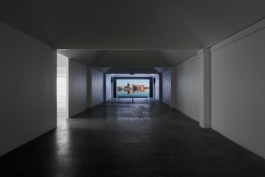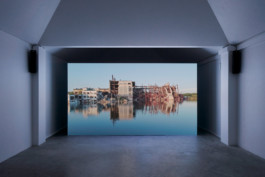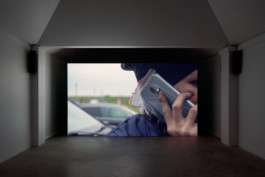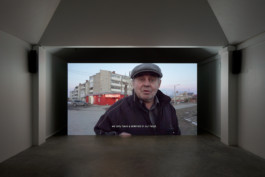BOTH EARS TO THE GROUND
Exhibition AMOUNT at Simian, Copenhague, 2022
Participating artists:
Lucie Stahl, Yuri Pattison, Naïmé Perrette, Toke Flyvholm





Extract of the exhibition text by Post Brothers:
The groundlessness of Pattison’s visualization can be compared to the progressive destabilization of the physical ground in Naïmé Perrette’s film Both Ears To The Ground (2021), which explores the social, cultural, and ecological environment of Berezniki, Russia, an industrial city in the Ural mountains that has become infamous for its massive sinkholes caused by mining. Berezniki lies on the Verkhnekamsk deposit of potassium-magnesium salts and most of the city’s residential buildings are located directly above the mines.12 In the last decades, these mines have increasingly flooded, eroding their soluble mineral supports and leading to collapses of the earth in the form of large sinkholes across the city. The city is literally losing ground and its water has become toxic and briny. Though these sinkholes have become sensational images for foreign journalists, for the citizens of Berezniki who largely work in the mines, they are simple facts of existence which have become so commonplace and normalized that the locals have given each familiar nicknames such as “the grandfather,” “big brother,” and “distant relative”. By interweaving this state of extraction, labour, and environmental collapse with forms of communal conviviality and survival, Perrette avoids the trope of the disastrous image and instead focuses on the human and non-human entanglements and conflicts in this intermingling of industry and culture.
One of the principal problems in studying human bioturbation or “anthroturbation”—the large-scale modification of the geologic structure of the earth via boreholes and mines—is that “the extent and geological significance of subsurface crustal modifications are commonly neglected: out of sight, out of mind.”13 A moment where the underground becomes blatantly visible, the sinkholes are not only a rupture in the physical fabric of the city, but a fracturing of notions of temporality, agency, and visibility, bringing into contact geology and biology. As Perrette has noted, “Sinkholes are a combination of human and natural processes, a rapid breaking point of slow movements happening out of sight, a conflict between spectacular occurrences and invisible dynamics.”14 In a series of almost phantasmagorical sequences, the artist and filmmaker ventures deep into the permeable and fractured spaces of the underground mines, exposing the variegated strata lining the bore holes and paths underneath the city, as well as the monstrous machines churning up material for industry. Amidst clouds of mineral dust contaminating their porous bodies, workers labour to extract salt15 and potash, which is used in fertilizers for industrial agriculture and comprises 10-20% of the global market. The continuing extraction of this material is indeed the result of what Karl Marx referred to as a “metabolic rift”16, where the over-extraction of nutrients from the soil has necessitated the constant accumulation of resources to serve as a supplement. Here, extraction is shown to produce rearrangements of matter that disfigure other organic and non-organic arrangements, such as bodies and land.
Perrette’s film approaches the sinkholes in an oblique way by frequently shifting her view from the mine to the everyday life of Berezniki’s inhabitants, occupying a different perspective from the sensationalist images in the media. Annoyed by the attention that the sinkholes have gotten, the people here do not embrace the doom and nihilism that such holes of oblivion propagate, instead they have an overall sense of optimism and routine. In addition to interviews with city residents and workers in the mines, a significant amount of attention is given to a local theatre troupe, whose role in the past and present has been to entertain the mine workers. Here, Perrette’s critical artistic investigation of the depiction of this place meets the notion of art as a refuge and momentary escape from our (ecopolitical) realities. The artist temporarily embedded herself into their community, and her presence not only became fodder for a local news report, but also was incorporated into the drama on stage. This logic of the artist as an implicated witness reaches its apotheosis in a scene at an after-rehearsal gathering, where one of the players explains to another: “He plays the role of a filmmaker and she’s a filmmaker filming the rehearsal of their play about the filmmaker who’s coming to the city to film a play rehearsal.” The almost fractal ramifications of this simulacral statement within the film affirms that the work is primarily concerned with the representation of the representation of the city, its sinkholes, and its inhabitants, rather than functioning as a straight-forward journalistic and disengaged documentary. One cannot help but marvel at the resilience of the people as the ground is literally and figuratively falling from under their feet. At the same time, their lack of concern is worrying yet familiar. Like us all, they are trying to persist amidst an increasingly impending crisis and cannot envision their lives any other way. Perrette avoids any moralizations regarding the people or the mines, focusing on the gaps in their relationship.
Presented within the massive cave-like hole of Simian, the film juxtaposes these realities to not only correspond events at the surface with the subterrain, but also to reveal this inherent separation, this fracturing of corporeal and mental capacities even in the face of palpable realities. The seemingly stable groundedness of our world caves in. The holes in the Earth correlate with the porosity of the bodies of the miners. The appearance of sinkholes, while being directly caused by anthropogenic changes to the geology of the area, itself directly interferes in the possibility of ongoing habitation and extraction. A local miner states in the film that he prefers to “move forward” and that “movement is life”, but we can also recognize that he is literally digging up the past and annihilating the future in this extraction, and that both life and the inorganic are at risk from this vocation. Berezniki’s sinkholes attest to the reality that the dark mines can no longer be regarded as inert grounds from which to accumulate resources, but instead operate as active forces that resist and (re)organize surface conditions. Rather than provide a simple and seamless thesis, Perrette’s film emphasizes the frictions and fractures between human and geological worlds and their spatial and temporal scales, dwelling in what Anna Tsing describes as “the sticky materiality of practical encounters,”17 to resist the spectacle of our contemporary “anthroposcenery”18.
